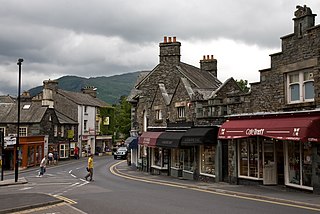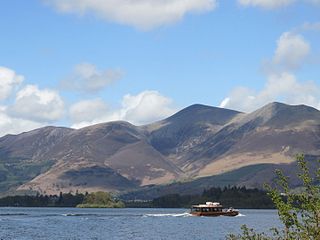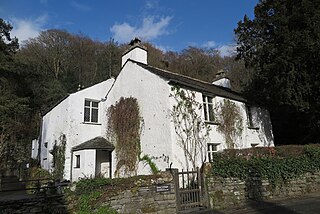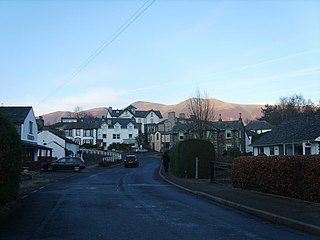History
Derwent Island was owned by Fountains Abbey and used by monks, but with the dissolution of the monasteries, it became property of the Crown in 1539. In 1569 it was sold to the Company of Mines Royal a subsidiary of a German mining company. The German miners built a camp on the island where they kept animals, grew vegetables and brewed beer. [2]
In 1778 Joseph Pocklington bought the island (then known as Vicar's Island) from Miles Ponsonby for £300. He built a house, boathouse, fort and battery, and Druid circle folly on the land. The house was one of the earliest villas to be built in the lake district, an entry in Pocklington's notebooks suggests that he saw a house on Belle Isle (in nearby Windermere lake) in 1776, perhaps inspiring his own ambition for a house on a lake district island. [3] Pocklington held annual regattas on the lake at which he fired off his cannon and the small fort used for mock battles. Pocklington sold the island to William Peachy in 1796, a friend of poet Robert Southey.
Henry Cowper Marshall purchased the island in 1844 and employed architect Anthony Salvin to add east and west wings and a three-storey tower to the house. [4] In 1951, Mr Marshall's grandson Denis Marshall gave the property to the National Trust.
During the 20th century, the house was home to several members of the Grindlay family who leased it from the Marshalls. [5]

The Lake District, also known as the Lakes or Lakeland, is a mountainous region and national park in North West England. It is primarily famous for its mountain, lake, and coastal scenery, and for its literary associations with William Wordsworth and other Lake Poets, Beatrix Potter, and John Ruskin.

Derwentwater, or Derwent Water, is a lake in the Lake District in North West England, immediately south of Keswick. It is in the unitary authority of Cumberland within the ceremonial county of Cumbria. It is the third largest lake by area, after Windermere and Ullswater. It has a length of 4.6 kilometres (2.9 mi), a maximum width of 1.91 kilometres (1.19 mi), and an area of 5.4 square kilometres (2.1 sq mi). Its primary inflow and outflow is the River Derwent, which also flows through Bassenthwaite Lake before reaching the Irish Sea at Workington. There are several islands within the lake, one of which is inhabited. Derwentwater is a place of considerable scenic value. It is surrounded by hills, and many of the slopes facing Derwentwater are extensively wooded. A regular passenger launch operates on the lake, taking passengers between various landing stages. There are seven lakeside marinas, the most popular stops being Keswick, Portinscale and the Lodore Falls, from which boats may be hired. Recreational walking is a major tourist activity in the area and there is an extensive network of footpaths in the hills and woods surrounding the lake.

Ambleside is a town and former civil parish in the Westmorland and Furness district of Cumbria, England. Within the boundaries of the historic county of Westmorland and located in the Lake District National Park, the town sits at the head of Windermere, England's largest natural lake. In 2020 it had an estimated population of 2596.

Keswick is a market town and civil parish in the Cumberland unitary authority area of Cumbria, England. Historically, until 1974, it was part of the county of Cumberland. It lies within the Lake District National Park, Keswick is just north of Derwentwater and is four miles from Bassenthwaite Lake. The parish had a population of 5,243 at the 2011 census.

Grasmere is a village and former civil parish, now in the parish of Lakes, in the Westmorland and Furness district of Cumbria, England, and situated in the centre of the Lake District and named after its adjacent lake. Grasmere lies within the historic county of Westmorland. The Ambleside and Grasmere ward had an estimated population of 4,592 in 2019. William and Dorothy Wordsworth, the 'Lake Poets', lived in Grasmere for 14 years and called it "the loveliest spot that man hath ever found."

Skiddaw is a mountain in the Lake District National Park in England. Its 931-metre (3,054 ft) summit is the sixth-highest in England. It lies just north of the town of Keswick, Cumbria, and dominates the skyline in this part of the northern lakes. It is the simplest of the Lake District mountains of this height to ascend and, as such, many walking guides recommend it to the occasional walker wishing to climb a mountain. This is the first summit of the fell running challenge known as the Bob Graham Round when undertaken in a clockwise direction.

Ullswater is a glacial lake in Cumbria, England and part of the Lake District National Park. It is the second largest lake in the region by both area and volume, after Windermere. The lake is about 7 miles (11 km) long, 0.75 miles (1 km) wide, and has a maximum depth of 63 metres (207 ft). Its outflow is River Eamont, which meets the River Eden at Brougham Castle before flowing into the Solway Firth. The lake is in the administrative county of Westmorland and Furness and the ceremonial county of Cumbria.

Rydal Mount is a house in the small village of Rydal, near Ambleside in the English Lake District. It is best known as the home of the poet William Wordsworth from 1813 to his death in 1850. It is currently operated as a writer's home museum.
Saint Herbert of Derwentwater was an Anglo-Saxon priest and hermit who lived on the small St Herbert's Island in Derwentwater, Cumbria, England. His friendship with St Cuthbert is explored in a poem by William Wordsworth.

Dove Cottage is a house on the edge of Grasmere in the Lake District of England. It is best known as the home of the poet William Wordsworth and his sister Dorothy Wordsworth from December 1799 to May 1808, where they spent over eight years of "plain living, but high thinking". During this period, William wrote much of the poetry for which he is remembered today, including his "Ode: Intimations of Immortality", "Ode to Duty", "My Heart Leaps Up" and "I Wandered Lonely as a Cloud", together with parts of his autobiographical epic, The Prelude.

Rydal is a village in Cumbria, England. It is a small cluster of houses, a hotel, and St Mary's Church, on the A591 road midway between Ambleside and Grasmere.

Storrs Hall is a hotel on the banks of Windermere in Storrs in the Lake District, Cumbria, England. The hotel, a Grade II* listed Georgian mansion, is also home to the National Trust-owned folly the "Temple" on the end of a stone jetty on Windermere. Situated in the Lake District, Storrs Hall sits alongside the Windermere.

Newlands Church is a 16th-century church situated less than 500 metres west of the hamlet of Little Town, Cumbria, England in the Newlands Valley of the Lake District. Its exact date of origin is unknown, but a map of 1576 shows a "Newlande Chap." on the site.

Portinscale is a village in Cumbria, England, close to the western shore of Derwentwater in the Lake District National Park 1+1⁄2 miles from Keswick.

Little Town is a hamlet in the civil parish of Above Derwent, in the Allerdale district of Cumbria, England. It is in the Workington constituency of the United Kingdom Parliament. Prior to Brexit in 2020 it was part of the North West England constituency of the European Parliament.

Crosthwaite Parish Church is a church at Great Crosthwaite on the outskirts of Keswick in Cumbria, England. It is dedicated to St Kentigern and is the Anglican church of the parish of Crosthwaite. Since 1951 it has been a Grade II* listed building. The church has an evangelical tradition.

Barrow House is a late 18th-century mansion situated on the eastern shore of Derwentwater in Borrowdale within the Lake District National Park, in the county of Cumbria, England. The house is a Grade II listed building which since the time of its construction has had various uses, it was originally a private dwelling and has since served as a hotel, a youth hostel run by the YHA and is now an independent hostel.

The Moot Hall is a prominent historic building situated at the southern end of Main Street in Keswick, Cumbria, England. It is Grade II* listed.
Island House may refer to the following structures:




















